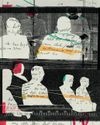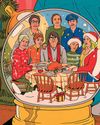
In mid-nineteenth-century London, which had a population upward of two million people, the journalist and social researcher Henry Mayhew set out to survey the lives of the working and nonworking poor. One of the now obsolete categories of labor he investigated was that of the cats’-meat men: sellers of boiled horseflesh, who purchased their stinking wares from knackers’ yards, then wheeled it in barrows along appointed routes each day, selling it to the public as cat food at two and a half pence per pound. By Mayhew’s reckoning, there were a thousand such venders in the capital, serving the needs of a feline population of three hundred thousand: roughly one cat per dwelling house. Cats had a liminal status, perceived by the humans they lived alongside as being somewhere between regulators of vermin—they helped control the population of rats and mice that flourished among the goods brought in and out of London’s teeming docks—and vermin themselves. Weasel-faced and rat-tailed, given to screeching and swiping, the mid-century cat was a rogue scavenger and a fit target for the cruelty of children, thanks to its own well-known predisposition to cruelty.
At the same time, however, a new cat was beginning to emerge. This was a round-faced, wide-eyed, sleek-bodied creature that was pampered, primped, and lavished with affection—like Oliver, a plump, stately, black domestic cat who was a member of a suburban household in the late nineteenth century and who, preserved in taxidermied condition with a yellow ribbon tied in a bow around his neck, is now in the collection of the Museum of London. Consider, too, the proliferating creatures drawn by Louis Wain, an artist born in Clerkenwell in 1860, whose anthropomorphized felines, engaged in activities such as playing cricket or singing in choirs, came to populate the pages of the Illustrated London News no less densely than their feral cousins prowled the warehouses along the Thames.
This story is from the June 10, 2024 edition of The New Yorker.
Start your 7-day Magzter GOLD free trial to access thousands of curated premium stories, and 9,000+ magazines and newspapers.
Already a subscriber ? Sign In
This story is from the June 10, 2024 edition of The New Yorker.
Start your 7-day Magzter GOLD free trial to access thousands of curated premium stories, and 9,000+ magazines and newspapers.
Already a subscriber? Sign In

GET IT TOGETHER
In the beginning was the mob, and the mob was bad. In Gibbon’s 1776 “Decline and Fall of the Roman Empire,” the Roman mob makes regular appearances, usually at the instigation of a demagogue, loudly demanding to be placated with free food and entertainment (“bread and circuses”), and, though they don’t get to rule, they sometimes get to choose who will.

GAINING CONTROL
The frenemies who fought to bring contraception to this country.

REBELS WITH A CAUSE
In the new FX/Hulu series “Say Nothing,” life as an armed revolutionary during the Troubles has—at least at first—an air of glamour.

AGAINST THE CURRENT
\"Give Me Carmelita Tropicana!,\" at Soho Rep, and \"Gatz,\" at the Public.

METAMORPHOSIS
The director Marielle Heller explores the feral side of child rearing.

THE BIG SPIN
A district attorney's office investigates how its prosecutors picked death-penalty juries.

THIS ELECTION JUST PROVES WHAT I ALREADY BELIEVED
I hate to say I told you so, but here we are. Kamala Harris’s loss will go down in history as a catastrophe that could have easily been avoided if more people had thought whatever I happen to think.

HOLD YOUR TONGUE
Can the world's most populous country protect its languages?

A LONG WAY HOME
Ordinarily, I hate staying at someone's house, but when Hugh and I visited his friend Mary in Maine we had no other choice.

YULE RULES
“Christmas Eve in Miller’s Point.”